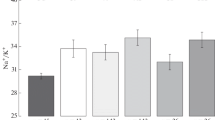Summary
The rhythm of renal sodium and potassium excretion was measured in 4-h-intervals in 12 subjects. Each person exhibited clear circadian variations of each variable with a maximum between 8 a.m. and 4 p.m. In each subject and for both circadian rhythms the oscillation mean was correlated to the range of oscillation (amplitude).
Increase in sodium or potassium excretion during 1 day resulted in an increase of oscillation range. The oscillation means of sodium and potassium periodicity did not correlate.
The properties of biological control systems with oscillating correcting variables are comparable to those of technical control systems. The significance of circadian rhythm for the control of electrolyte balance is indicated.
Similar content being viewed by others
References
Aschoff, J.: Gesetzmäßigkeiten der biologischen Tagesperiodik. Dtsch. med. Wschr.88, 1930–1937 (1963)
Aschoff, J., Wever, R.: Biologische Rhythmen und Regelung. In: Probleme der zentralnervösen Regulation, Bad Oeynhausener Gespräche, 1962
Aschoff, J., Klotter, K., Wever, R.: Circadian vocabulary. In: Circadian clocks (Aschoff, ed.), pp. X–XIX. Amsterdam 1965
Bahlmann, I., McDonald, S. I., Veutom, M. G., De Wardener, H. E.: The effect on urinary sodium excretion of blood volume expansion without changing the composition of blood in the dog. Clin. Sci.32, 404–413 (1967)
Baldwin, D., Alexander, R. W., Warner, E. G.: Chronic sodium chloride challenge studies in man. J. Lab. clin. Med.55, 362–375 (1960)
Buchborn, E., Koczorek, K. R., Wolff, H. P.: Aldosteronausscheidung und tubuläre Nierenfunktion. Klin. Wschr.35, 452–459 (1957)
Campbell, I. A., Webster, T. A.: XIV. Note on urinary and excretory rhythms. Biochem. J.16, 507–513 (1922)
Gerritzen, F.: Der 24-Stunden-Rhythmus in der Diurese. Dtsch. med. Wschr.64, 746–748 (1938)
Goldman, R.: Studies in diurnal variation of water and electrolyte excretion: Nocturnal diuresis of water and sodium in congestive cardiac failure and cirrhosis of the liver. J. clin. Invest.30, 1191–1199 (1951)
Halberg, F., Engel, R., Swank, R., Seaman, G., Hissen, W.: Cosinor-Auswertung circadianer Rhythmen mit niedriger Amplitude im menschlichen Organismus. Physik. Med. und Rehab.7, 101–107 (1966)
Holzgreve, H., Schrier, R. W., Eigler, J.: Renale Regulation des natriumhaushaltes. Internist12, 69–76 (1971)
Hun Ki Min, Jones, I. E., Flink, E. B.: Circadian variations in renal excretion of magnesium, calcium, phosphorus, sodium, and potassium during frequent feeding and fasting. Fed. Proc.25, 917–921 (1966)
Klahr, S., Slatopolsky, E.: Renal regulation of sodium excretion. Arch. intern. Med.131, 780–791 (1973)
Mann, H., Rutenfranz, J., Wever, R.: Untersuchungen zur Tagesperiodik der Reaktionszeit bei Nachtarbeit. II. Beziehungen zwischen Gleichwert und Schwingungsbreite. Int. Arch. Arbeitsmed.29, 175–187 (1972)
Menzel, W.: Menschliche Tag- und Nachtrhythmik und Schichtarbeit. Basel: Schwabe Verlag 1962
Menzel, W., Blume, I., Silver, R., Luca, E.: Über die Periodik der Nierentätigkeit bei Gesunden und Nierenkranken. Verh. Arch. Ges. inn. Med.58, 292–294 (1952)
Oppelt, W.: Kleines Handbuch technischer Regelvorgänge. Weinheim: Verlag Chemie GmbH 1954
Reinhardt, H. W., Behrenbeck, D. W.: Untersuchungen an wachen Hunden über die Einstellung der Natriumbilanz. I. Die Bedeutung des Extracellulärraumes für die Einstellung der Natrium-Tagesbilanz. Pflügers Arch. ges. Physiol.295, 266–279 (1967)
Runcie, I.: Urinary sodium and potassium excretion in fasting obese subjects. Brit. med. J. 1971II, 22–25
Schultze, R. G.: Recent advances in the physiology and pathophysiology of potassium excretion. Arch. intern. Med.131, 885–897 (1973)
Strauss, M. B., Lamdin, E., Smith, W. P., Bleifer, D. J.: Surfeit and deficit of sodium. Arch. intern. Med.102, 527–536 (1958)
Wisser, H., Doerr, P., Stamm, D., Fatranska, R., Giedke, H., Wever, R.: Tagesperiodik der Ausscheidung von Elektrolyten, Katecholaminmetaboliten und 17-Hydroxycorticosteroiden im Harn. Klin. Wschr.51, 242–246 (1973)
Wever, R.: Zum Problem der Regelung in der Biologie. Pflügers Arch. ges. Physiol.278, 89–90 (1963a)
Wever, R.: Zum Mechanismus der biologischen 24-Stunden-Periodik. II. Mitteilung: Der Einfluß des Gleichwertes auf die Eigenschaften selbsterregter Schwingungen. Kybernetik,1, 213–231 (1963b)
Wever, R.: Ein mathematisches Modell für die circadiane Periodik. Z. angew. Math. Mech.46, 148–157 (1966)
Author information
Authors and Affiliations
Rights and permissions
About this article
Cite this article
Mann, H., Stiller, S. & Korz, R. Biological balance of sodium and potassium. Pflugers Arch. 362, 135–139 (1976). https://doi.org/10.1007/BF00583639
Received:
Issue Date:
DOI: https://doi.org/10.1007/BF00583639



